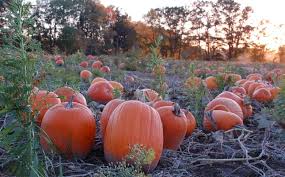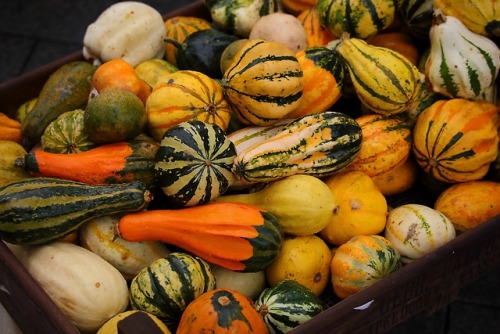Foods of The Americas: Squash, the ‘noblest’ of vegetables
Editor’s note: Michelle’s Foods of The Americas series continues this week with the first of a three-column series on squash, the noblest of vegetables.

Michelle Bakeman
By Michelle Bakeman
The following is an excerpt from “The Pumpkin,” by fireside poet John Greenleaf Whittier:
On the banks of the Xenil the dark Spanish maiden
Comes up with the fruit of the tangled vine laden;
And the Creole of Cuba laughs out to behold
Through orange-leaves shining the broad spheres of gold;
Yet with dearer delight from his home in the North,
On the fields of his harvest the Yankee looks forth,
Where crook-necks are coiling and yellow fruit shines,
And the sun of September melts down on his vines.
Fairer hands never wrought at a pastry more fine,
Brighter eyes never watched o’er its baking, than thine!
And the prayer, which my mouth is too full to express,
Swells my heart that thy shadow may never be less,
That the days of thy lot may be lengthened below,
And the fame of thy worth like a pumpkin-vine grow,
And thy life be as sweet, and its last sunset sky
Golden-tinted and fair as thy own Pumpkin pie!

There comes a moment in every woman’s life when she feels compelled to acquiesce to those rumors that circulate among those who know her. For me, that moment is now. So here goes: yes, it’s true. I am a bona fide, unapologetic, ruthless fruit and vegetable junkie. I can’t get enough of them. I adore and worship them as the billions of exploded, fragrant rainbow molecules that they are; fallen to the earth from the heavens, sparks of radiant color in the green foliage, arrogant and voluptuous, exuding a kind of cosmic magic that speaks of a colossal and universal truth.
The squash are the valiant champions, the flower-crowned vine clinging chameleons hiding inside the tastiest dishes; puréed they become liquid velvet on the tongue, roasted the sweetest candy, grilled they radiate the smokiness of molten fire, and nestled inside a dumpling or a golden pie crust they are the heart and soul of Nature’s bounty. I line them up along my kitchen counter, some of them pear-shaped like Venus herself, some of them sleek and Herculean, and still others robust and plump globes, like Cinderella’s moonlit coach.
 They sit in their quiet majesty, in the naked honesty of their fleshy vulnerability inside a defiant exterior of armored skin, and they contemplate me, their conqueror, before surrendering to the blade of my knife as they accept their fates; this one will be a crispy fritter adorned with a tangy, glistening tomato sauce and bubbly melted cheese, that one a stir-fried gem in an orange and soy glaze with sesame seeds, another a purée, married off to a suitor of cream and pesto to create a rich Italian soup on a cold, winter’s night, and the last of them the secret and tender ingredient in Sunday’s breakfast bread, sliced hot and throwing curls of steam into the morning sunbeams that pierce the windows of my kitchen, dripping with butter, the perfect partner to my coffee, while I, lazy and warm in my fuzzy socks, am convinced for just a few fleeting moments that all is right with the world. So yeah…………………in case you were wondering, I really…………really……………… like squash.
They sit in their quiet majesty, in the naked honesty of their fleshy vulnerability inside a defiant exterior of armored skin, and they contemplate me, their conqueror, before surrendering to the blade of my knife as they accept their fates; this one will be a crispy fritter adorned with a tangy, glistening tomato sauce and bubbly melted cheese, that one a stir-fried gem in an orange and soy glaze with sesame seeds, another a purée, married off to a suitor of cream and pesto to create a rich Italian soup on a cold, winter’s night, and the last of them the secret and tender ingredient in Sunday’s breakfast bread, sliced hot and throwing curls of steam into the morning sunbeams that pierce the windows of my kitchen, dripping with butter, the perfect partner to my coffee, while I, lazy and warm in my fuzzy socks, am convinced for just a few fleeting moments that all is right with the world. So yeah…………………in case you were wondering, I really…………really……………… like squash.
Where did squash come from? Why are there so many shapes and sizes and colors? The word squash was born of the Native American Narrangansett word askutasquash meaning “a green eaten raw.” The Narragansett people are the descendants of the inhabitants of the geographical area of modern-day Rhode Island, of a group of people establishing themselves there thousands of years ago. And while in English we refer to the members of the gourd family (Cucurbitaceae) as squash (genus Cucurbita) after that catchy Narragansett word, the fact is that the members of the genus Cucurbita actually originated in Mesoamerica, spreading quickly to both North and South America. The Cucurbitaceae family of flowering plants includes the cucumber, melon, and watermelon, and can boast to be some of the first plants cultivated in both the New and Old Worlds. The genus Cucurbita is split into six species, four of which are widely cultivated as squash. Those species include the following:
- Cucurbita maxima- hubbard and buttercup squash
- mixta- cushaw squash
- moschata- butternut squash
- pepo- zucchini, summer squashes, pumpkins, acorn squash, spaghetti squash
While squash are technically classified as fruit, they are viewed as and served as vegetables. They are very nutritious human food, containing beneficial amounts of vitamins A, C, and E, vitamin B6, niacin, riboflavin, and iron. Additionally, they also appeal to the senses, showing up in a wide spectrum of colors from white to yellow, light to dark green, and orange. They can be solid colored to variegated, with thin to thick, smooth to rough-textured and even dimpled rinds, and they delight us with their shapes, from spheres to cylinders, to flattened discs and crooknecks. With their vast array of facades, not to mention their delicious taste and aroma, it is no wonder that we gravitate to them.
They grant us not only their delicate, tender flesh but in addition their seeds and their blossoms, which are also edible. Most of us are unaware of their multi-species classification, denoted mainly by the differences in the shape, size, and consistency of the fruits’ stems; some are hard, while others spongy, some angular, ridged, smooth, or swollen, some large, while others small relative to their fruit. So rather than identify them according to species, which can get confusing, we simply divide them into two main groups: summer squash and winter squash, categories that are distinguished based on the level of maturity at which the squash is consumed. Summer squash are small, rapid-growing, spreading bush varieties with soft, edible rinds that are consumed soon after harvested. Zucchini are the perfect example of summer squash. Winter squash, on the other hand, are large, vine-growing fruit with hard, inedible rinds. These squash grow slowly and may be stored in cool, dry areas for longer periods of time after the harvest. Examples of winter squash include butternut, acorn, spaghetti, and pumpkins.
The ancient relatives of today’s squashes, because of their almost impenetrable rinds, bitter taste, and even poisonous nature, were supposedly never meant to be consumed by the smaller creatures that roamed this planet and happened upon them thousands of years ago, but rather by the giants of the mammal world, those whose power and size would have kept them safe from the toxins of the fruits, those herbivores whose jaws and teeth would have been formed in such a way to slice and rip through the rock hard shells of even the toughest squash and gourds.

Shovel Tusked Gomphothere Model. Gomphotheriidae Amebelodon. Credit: Panhandle Plains Historical Museum. Canyon Texas.
Some of these creatures were called mastodons, which were distantly related to modern-day elephants. Others included giant ground sloths, weighing more than 2500 pounds, and gomphotheres, which were, like mastodons, elephant-like animals who possessed long, specialized teeth and shovel-shaped tusks that extended from their lower jaw that would have aided in pulling and scooping up a variety of tough vegetation all across the existing grasslands, forests, and even marshlands that once covered Mesoamerica. The efforts of these kinds of grazing mammals maintained large tracts of terrain in such a way to provide an ideal habitat for the ancient vine-growing squashes, which needed room to spread and could not have survived among the thick green cover of a jungle floor. As the fruits were crushed and broken in the powerful jaws of the roaming giants, their seeds would have fallen to the earth, producing more and more plants as part of a life cycle that went on, undisturbed for millennia.
And then, approximately 14,000 years ago, humans entered the scene, hunters who initiated the roughly 4000-year process of eradicating the region of the titans that acted as its gardeners. Quickly their numbers began to dwindle, and that fact, coupled with the drastic climate shifts that occurred between 11,000 and 9,000 years ago, led to the extinction of many of the Cucurbit species, as the grasslands once groomed by the grazing herds gave way to dense, tropical vegetation not suited to the spread of squash. Those species that managed to survive did so, ironically, at the behest of human intervention. The early humans of the Americas, after inadvertently aiding in wiping out numerous Cucurbits, began domesticating others; most likely this was in an effort to reproduce the gourds they found as storage containers for foodstuffs and water rather than as food themselves.
 Over time, the people would have begun to realize that certain Cucurbit species with softer rinds and a less bitter taste were also suitable for human consumption, and naturally, they would have begun cultivating those as well. It was in the area that is now Mexico where squash first emerged as a domesticated crop, subsequently appearing again and again in patches in North and South America wherever human beings were settling and carving out the terrain to make it optimal for farming. As a result, squash may claim its role as one of the earliest and most important crops cultivated by humankind.
Over time, the people would have begun to realize that certain Cucurbit species with softer rinds and a less bitter taste were also suitable for human consumption, and naturally, they would have begun cultivating those as well. It was in the area that is now Mexico where squash first emerged as a domesticated crop, subsequently appearing again and again in patches in North and South America wherever human beings were settling and carving out the terrain to make it optimal for farming. As a result, squash may claim its role as one of the earliest and most important crops cultivated by humankind.
Next in the series on squash, learn how this fruit took center stage in the everyday lives of Native Americans, who not only cherished it for nourishing their bodies but also revered it in their folklore and cultural ceremonies. Stay tuned.
Sources:
New World Encyclopedia: Squash
Popular Science: Domestication saved pumpkins and squash from extinction.
Michelle Bakeman has a bachelor’s degree from the University of Virginia in Spanish and Latin American Studies. She is also a graduate of the Culinary Arts Institute of Louisiana. She has been a chef for twenty-two years, has owned and operated several restaurants, and has been a teacher for sixteen years. She moved to Cuenca in 2013.




















